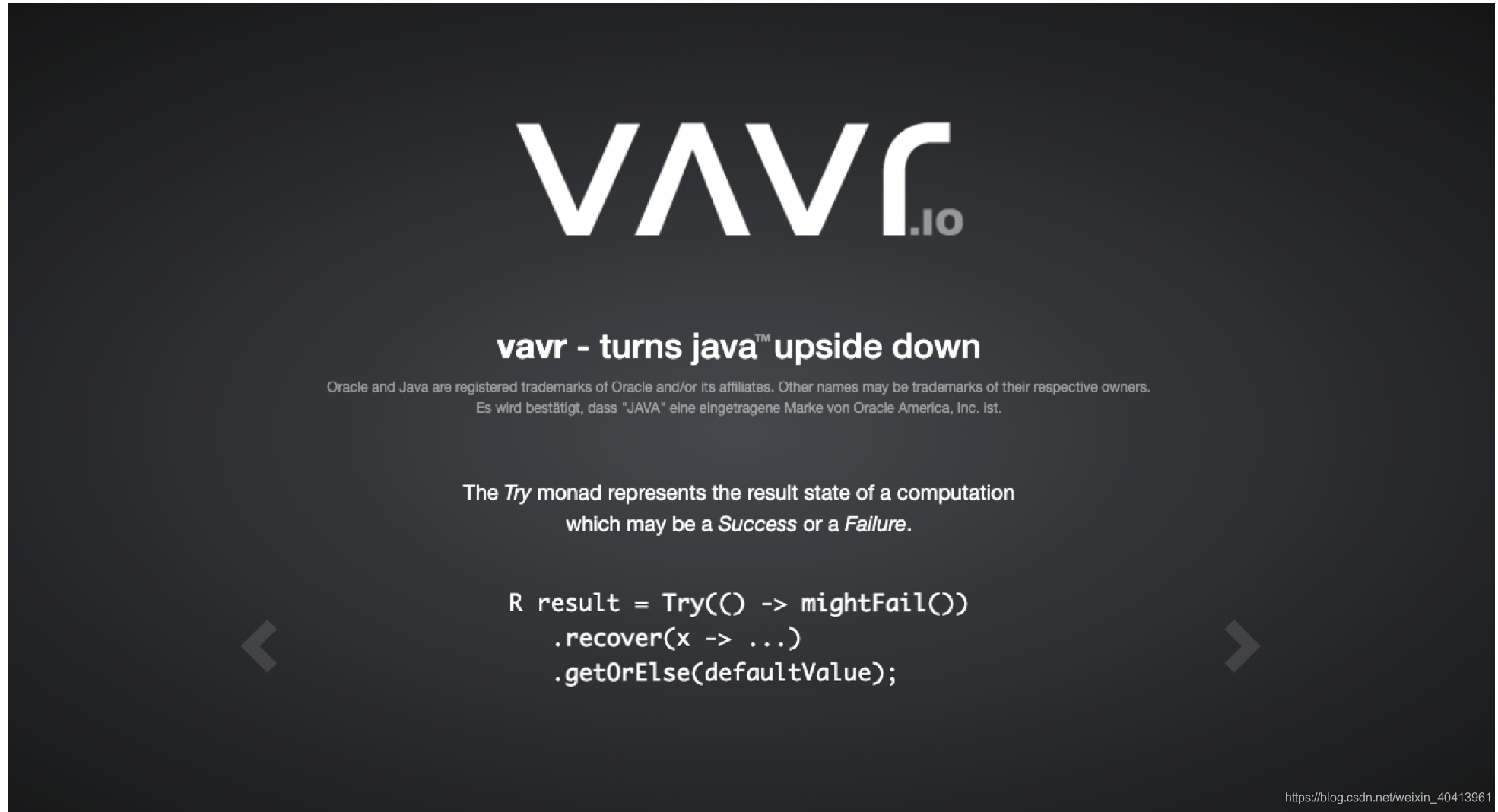
什么是函数式编程
- 基本概念:他是一种编程范式,对于函数式编程来说,它只关心定义输入数据和输出数据相关的关系,数学表达式里面其实是在做一种映射(mapping),输入的数据和输出的数据关系是什么样的,是用函数来定义的。
- 特征:
- stateless:函数不维护任何状态。函数式编程的核心精神是 stateless,简而言之就是它不能存在状态,打个比方,你给我数据我处理完扔出来。里面的数据是不变的。
- immutable:输入数据是不能动的,动了输入数据就有危险,所以要返回新的数据集。(不可变的)
Java为什么要函数式编程
- 优势
- 没有状态就没有伤害。
- 并行执行无伤害。
- Copy-Paste 重构代码无伤害。
- 函数的执行没有顺序上的问题。
问题所在
- 函数式相对于普通的java变成来说,如果没有用过就会直接不清楚这个函数是干什么的,这个是干什么的,如果在团队中只有部分人使用,那我们在其他人在理解我们的代码上就会有问题,也就回增加学习成本,和开发成本。
- 使用的问题:问题排查的问题 和异常的捕获的问题。
EXAMPLE
package Vavr;
import com.google.common.collect.Lists;
import com.google.common.collect.Maps;
import com.sun.istack.internal.FragmentContentHandler;
import io.vavr.CheckedFunction0;
import io.vavr.Function1;
import io.vavr.Function2;
import io.vavr.Function3;
import io.vavr.Lazy;
import io.vavr.Tuple;
import io.vavr.Tuple2;
import io.vavr.control.Either;
import io.vavr.control.Option;
import io.vavr.control.Try;
import java.math.BigInteger;
import java.util.Arrays;
import java.util.HashMap;
import java.util.List;
import java.util.Map;
import java.util.Optional;
import java.util.concurrent.ThreadLocalRandom;
import javax.annotation.Generated;
import lombok.Getter;
/**
* 函数式编程demo
*
* @author yuanxindong
* @date 4/17/21 7:30 PM
*/
public class VavrTest {
/**
* 元组的使用
*/
public static void tupleTest() {
//of 静态方法支持使用
Tuple2<String, Integer> tuple2 = Tuple.of("Hello", 100);
Tuple2<String, Integer> updatedTuple2 = tuple2.map(String::toUpperCase, v -> v * 5);
String result = updatedTuple2.apply((str, number) -> String.join(", ",
str, number.toString()));
System.out.println(result);
}
/**
* function函数的使用
*/
public static void functionTest() {
// 函数定义,前3个是入参,最后是R
Function3<Integer, Integer, Integer, Integer> function3 = (v1, v2, v3) -> (v1 + v2) * v3;
// 函数的组合
Function3<Integer, Integer, Integer, Integer> composed =
function3.andThen(v -> v * 100);
//执行结果
int result = composed.apply(1, 2, 3);
System.out.println(result);
//还有包含部分函数的应用
Function1<Integer, Integer> function1 = function3.apply(1, 2);
Integer apply = function1.apply(1);
System.out.println(apply);
//项目联想
//结合项目场景使用比如说PDT中定义几个 函数比如:计算MP时效的函数,计算ALG的函数时效,在定义一些函数结果的拼接等
}
/**
* 柯里化想要解决的问题: 柯里化方法的使用 柯里化的含义: 柯里化(currying)是与λ演算相关的重要概念。通过柯里化,可以把有多个输入的函数转换成只有一个输入的函数,从而可以在λ演算中来表示。 柯里化的名称来源于数学家 Haskell Curry。 Haskell Curry 是一位传奇性的人物,以他的名字命令了 3 种编程语言,Haskell、Brook 和 Curry。
* 柯里化是把有多个输入参数的求值过程,转换成多个只包含一个参数的函数的求值过程。 对于清单 6 的函数 f(a, b, c),在柯里化之后转换成函数 g,则对应的调用方式是 g(a)(b)(c)。 函数 (x, y) -> x + y 经过柯里化之后的结果是 x -> (y -> x + y)。
*/
public static void curriedTest() {
//设置函数 v1 v
Function3<Integer, Integer, Integer, Integer> function3 = (v1, v2, v3) -> (v1 + v2) * v3;
//可以看出来是返回来了一个函数
Function1<Integer, Function1<Integer, Integer>> apply = function3.curried().apply(1);
//多次柯里化后就会返回我们想要的记过
int result = function3.curried().apply(1).curried().apply(2).curried().apply(3);
System.out.println(result);
}
/**
* 记忆化方法 会将之前计算过的方法进行存储,相同参数在第二次调用的时候会使用缓存
*/
public static void memoized() {
//计算差方
Function2<BigInteger, Integer, BigInteger> pow = BigInteger::pow;
//记忆化
Function2<BigInteger, Integer, BigInteger> memoized = pow.memoized();
long start = System.currentTimeMillis();
memoized.apply(BigInteger.valueOf(1024), 1024);
long end1 = System.currentTimeMillis();
memoized.apply(BigInteger.valueOf(1024), 1024);
long end2 = System.currentTimeMillis();
System.out.printf("%d ms -> %d ms", end1 - start, end2 - end1);
}
/**
* java 8 中的optional 是类似 其目的都是为了避免NPE的出现
*/
public static void optionTest() {
//个人觉得option好用的地方在于这个of 静态函数。
Option<String> str = Option.of("Hello");
str.map(String::length);
//使用对应的值
Option<Integer> integers = str.flatMap(v -> Option.of(v.length()));
boolean empty = integers.isEmpty();
System.out.println(integers);
}
/**
* either 的使用 包含两个值,left(异常值) 和 right(正确值)
*/
public static void eitherAndTryTest() {
//这个是
Either<String, String> either =
compute()
.map(str -> str + " World")
.mapLeft(Throwable::getMessage);
System.out.println(either);
//Try的使用,不用写过多的catch,左后将left值交给某一个函数统一处理,
//在pdt中有很多这样的代码,try catch 嵌套起来使用 包含参数定义的参数校验异常
//
Fruit.fromColor("1111");
}
private static ThreadLocalRandom random = ThreadLocalRandom.current();
private static Either<Throwable, String> compute() {
return random.nextBoolean()
? Either.left(new RuntimeException("Boom!"))
: Either.right("Hello");
}
@Getter
public enum Fruit {
APPLE("APPLE", "BLACK"),
BANANA("BANANA", "BLUE"),
NONE("ORANGE", "WHITE");
private final String name;
private final String color;
Fruit(String name, String color) {
this.name = name;
this.color = color;
}
public static Fruit fromColor(String color) {
return Try.of(() -> Arrays.stream(Fruit.values())
.filter(t -> t.getColor().equals(color))
.findFirst().orElse(NONE))
.toEither().getOrElse(NONE);
}
}
/**
* Lazy 表示的是一个延迟计算的值。在第一次访问时才会进行求值操作,而且该值只会计算一次。之后的访问操作获取的是缓存的值。 Lazy.of 从接口 Supplier 中创建 Lazy 对象。方法 isEvaluated 可以判断 Lazy 对象是否已经被求值。
*/
public static void LazyTest() {
Lazy<BigInteger> lazy = Lazy.of(() ->
BigInteger.valueOf(1024).pow(1024));
System.out.println(lazy.isEvaluated());
System.out.println(lazy.get());
System.out.println(lazy.isEvaluated());
System.out.println(lazy.get());
System.out.println(lazy.isEvaluated());
Lazy<BigInteger> lazy2 = Lazy.of(() ->
BigInteger.valueOf(1024).pow(1024));
System.out.println(lazy2.isEvaluated());
System.out.println(lazy2.get());
//未想到应用场景
}
public static void main(String[] args) {
tupleTest();
functionTest();
curriedTest();
memoized();
LazyTest();
}
}























 5191
5191

 被折叠的 条评论
为什么被折叠?
被折叠的 条评论
为什么被折叠?








